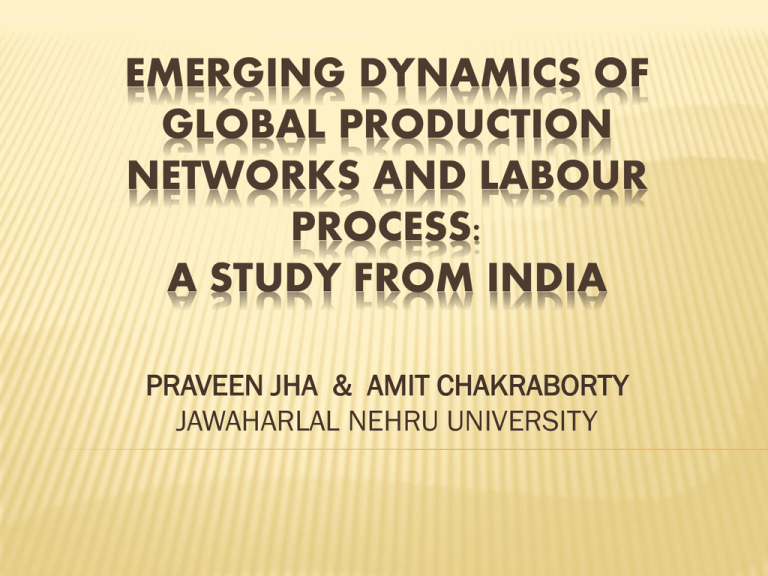emerging dynamics of global production networks and labour process
advertisement

EMERGING DYNAMICS OF GLOBAL PRODUCTION NETWORKS AND LABOUR PROCESS: A STUDY FROM INDIA PRAVEEN JHA & AMIT CHAKRABORTY JAWAHARLAL NEHRU UNIVERSITY INTRODUCTION A significant restructuring of organization of production under capitalism in last couple of decades, Trans-nationalization of production with a major shift of production base to low-cost developing countries. The globalization of production in automobile industry, accompanied by the progressive use of advanced manufacturing technology (AMT) and lean production techniques to organize production and work, has epitomized this global changes. This has transformed labour process and triggered workers’ response. The emerging dynamics of GPN and labour process -- a dynamic interaction of capital’s strategy, technology and agency of labour. OUTLINE OF A THEORETICAL FRAMEWORK Capitalism, in Marxist understanding, as a spontaneous system, driven by insatiable quest for surplus value or profit. Powerful impulses associated with the immanent tendencies of capitalism -- described by Marx as the ‘laws of motion of capitalism’– under substantial regulation in the accumulation regime of post-WW II era. Pressure on profit margin from late-sixties. Regulations gradually withdrawn. A new regime of accumulation, i.e. neo-liberalism. Collective bargaining power of workers had to be broken down (Harvey,2005). Reserve army of labour in developing world ensured low-wage regime for production (Foster, 2010). Ascendency of GPN. THEORETICAL FRAMEWORK CONTD… Labour process as the dialectic between immanent tendencies of capitalism and agency of labour in the production sphere. Formal and real subsumption of labour under capital – subsuming earlier modes of productions under capitalist production to appropriate absolute surplus value; and subsequent intensification of work by revolutionizing production techniques to appropriate relative surplus value. Two contentious issues between capital and labour in shaping labour process – how the organization of labour serves the interest of the dominant class, and, how does it facilitate overall control of the dominant class? THEORETICAL FRAMEWORK CONTD… Braverman (1974) studies degradation of work, separation between conceptualization and execution of work or the operation of Taylorist principles under Fordist mass production. Marglin (1974) – technological and economic efficiency aspired by capital. Debates and divergence of different tendencies in postBraverman labour process theory. Some attempts to go beyond shop-floor and connect labour process with the perspective of larger political economy. Need to develop a framework to capture the dynamics between the emergence of GPN and the transformation of labour process. INDIAN AUTO INDUSTRY AND GURGAONMANESAR CLUSTER Import Substitution Industrialization till 1980s. Significant restructuring thereafter, and rapid integration with complex network of global auto production with further liberalization in last two decades. Gurgaon-Manesar cluster – a major destination of global auto production with lead firms, global component suppliers and deep backward linkages extending up to slum production. Increasing role of 1st tier suppliers to design and assemble components according to the assembler’s specification, adopt AMT and JIT or lean production, exploit economies of scale. Joint ventures, mergers and just-in-time delivery resulting in complex interdependence within cluster. PRODUCTION PROCESS IN MARUTI SUZUKI MANESAR PLANT Continuous flow of work from press shop to weld shop, then to paint shop and finally in the assembly line. Strong internal segmentation of workforce – permanent, contract, trainee, apprentice, and even workers of vendor companies working in the same premises. Segmentation in terms of internal labour market. Increasing mechanization and increasing intensification of work, with sophisticated managerial control. ‘electronic flow’-management to reconcile technical productivity and profitability, synchronizing supply chain from extreme end to shop floor welding robots. THE SUPPLY CHAIN With ‘no single source’ policy, and with 250-odd 1st tier suppliers and hundreds of lower tier vendor companies, supply is a seamless activity. Lead firms like Maruti Suzuki not only outsource production activities or stock of products, but financial risks. Increasing polarization of suppliers – rise of global players in the 1st tier for standardization and quality, and parallel subsumption of low-wage labour intensive regime at bottom, extending up to slum production. Suppliers at the lower end of the chain facing two-fold squeeze – from the lead firms or component assemblers who pressurize for further cost-cutting to maintain their mark-up; and, increasing price pressure for input( steel or rubber) -- very limited scope to expand capacity. Consequence for labour. MARUTI SUZUKI AND HINDUSTAN MOTORS: JUXTAPOSING TWO PRODUCTION REGIMES Maruti Suzuki -- an assembly plant producing very few components, with negligible inventory and embedded in just-in-time supply chain under GPN. Value added depends on increasing intensity of work, i.e. relative surplus value. Internal segmentation of workforce or internal labour market substantial. Hindustan Motors – a production plant producing most of the components including the forging or foundry works representing earlier production regime. Scope to increase relative surplus value is constrained by labour process or technology. Segmentation or internal labour market less significant. MARUTI SUZUKI AND HINDUSTAN MOTORS: JUXTAPOSING TWO PRODUCTION REGIMES Experience is replaced by professional training, ITI diploma needed. Centralized production system, AMT, ‘flexibility’ of different kinds expand scope for centralized control, autonomy of floor managers reduced. ‘Manufacturing consent’ for technological change or productivity rise ---production incentive, quality circles, Japan visit. Experience over time on the shop floor is important. Few with ITI diploma. Less ‘flexible’. Increase of speed of ‘car line’ may lead to fall of quality, more breathing space for workers. More autonomy for floor managers. Hegemonic control is not so significant. No provision of production incentive. GURGAON AUTOMOBILE CLUSTER: THE STRUCTURAL UNEVENNESS ‘Unity of opposites’ embedded in ‘combined and uneven development’- Within the ‘modern’ firm -- sophisticated mechanization with brutal use of cheap labour; Along the supply chain -- lower segment co-opted to produce more absolute surplus value for assemblers; Regional unevenness – old industrial areas (e.g Faridabad) including workers’ jhuggis subsumed under new regime. GURGAON AUTOMOBILE CLUSTER: THE STRUCTURAL UNEVENNESS Siphoning of surplus and transfer of crisis -Within factory -- internal segmentation within the workforce increasing contractualisation and intensification of work (e.g. post-2008 Maruti); Opening new unit with less bargaining power of workers (e.g. Maruti Suzuki Manesar plant B); Along supply chain – cost-cutting, financial risk transfer, burden of over or under-capacity production Use of reserve army of labour in periphery of production. ISSUES OF TECHNOLOGY Two important dimensions of technological change – a capitalcapital (competition among capitalists) one; and, a capitallabour (class domination and control) one. Technology not ‘exogenous’ to labour process’, neither a ‘blackbox’. Technological changes – incremental changes in the shop floor; adoption of AMT. Mechanization of three different processes of production (Bell, 1972, Blackburn et al. 1985) – transformation, transfer and control. Technology in GPN has revolutionized the process of control, both on individual machines and on other two processes, and made labour process amenable to different ‘flexibilities’. ISSUES OF MANAGERIAL CONTROL AND WORKERS’ AUTONOMY In the upper strata of production network, larger participation of a section of workers encouraged to use their tacit knowledge of labour process to streamline and intensify their work. Re-linking conception and execution to a limited sense (e.g. linking CAD-CAM) for the same. With sophisticated managerial control, more intensified form of Taylorism. A rising clash of Technocratic logic and democratic logic. Social hierarchy reproduced on the shop floor. Various socio-cultural-religious forms are used to assure hegemonic control over the workers. ISSUES OF SKILL Question of skill to be understood with many-fold dimensions like craft-input, know-how, experience, valuation etc. General decline in terms of craft input. Know-how increases or decreases depending on the nature of technological change or reorganization of production influencing labour process. Experience less important as easily replicable by training and ‘devalued’ because of continuous transformation in labour process due to technological changes. Possession of ‘devalued’ skill due to technological shifts causes lack of confidence and increases job insecurity. WORKERS’ RESPONSE Strike waves in last couple of years in automobile industry in Gurgaon-Manesar cluster and beyond (including militant strike and occupation in Maruti Suzuki Manesar plant in 2011 in three phases). Outside India, similar trends in other developing countries (e.g. China, Mexico) visible. Important dimensions – Most often deeply grounded in labour process, concrete experience of shop-floor working conditions. Spontaneous in character, solidarity of permanent and contract workers. Use of strategies that go beyond traditional legal trade unionist framework – factory occupation, solidarity strikes. WORKERS’ RESPONSE Old trade union form undermined by capital due to shifting work organization, new technology and redesigning of job, increased mobility of capital, increasing contractualisation and Informalisation. Embryonic form of plant-level workers’ self-organization visible in struggle. Exposing a new kind of vulnerability of firms under GPN by paralyzing the production chain (e.g. Rico strike, 2009, Maruti Strike 2011). Participation of a new young, militant, skilled workforce, due to a transition from formal to real subsumption of labour under capital, from appropriation of absolute surplus value to relative surplus value in labour process in the new assembly points and clusters under GPN. CAPITAL’S STRATEGIC RESPONSE Crush the movement and go for the necessary restructuring of work, technology and production process to undermine workers’ strength in the long run (e.g. Maruti strike in 2000, Rico strike in 2009). If not possible then try to contain the movement, transfer the crisis and go for gradual restructuring to undermine workers’ resistance. E.g. Maruti Suzuki strike in 2011 where a forced compromise to accept many demands leads management for immediate transfer of crisis via supply chain, plant B, to adopt ITIs, and go for gradual restructuring. CONCLUDING REMARKS Vulnerability of workers under GPN on the rise globally. Global South struggling against low-wage regime, against harsh working condition, for unionization. Workers of global North facing wage-cuts, job-cuts, casualisation. With the ascendency of GPN, share of wages in total output falling. Promises of workplace democracy, autonomy, reskilling do not seem to deliver much. When ‘modern’ segment in the production network feeds on the existence of a low-wage, labour-intensive, CONCLUDING REMARKS technologically backward segment, embedded in a combined and uneven development, unilinear ideas of ‘social’ or ‘technical’ upgrading in the production network do not hold. There seems to be a potential threat for many part of the production chain in GPN to be converted into radical chain, but the form and strategy of labour vis-à-vis global capital is still an open question.







